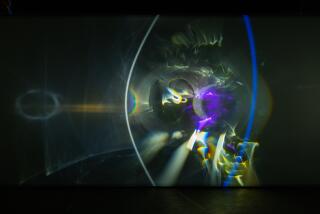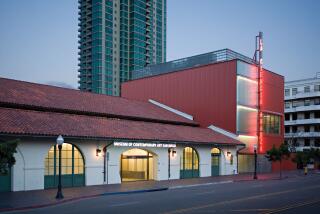Connecting life and art
- Share via
The first few times I took my kids to the Museum of Contemporary Art, the visits weren’t completely successful. Both children loved the Grand Avenue building, with its pyramid top and the exciting descent down the stairs into the museum. But looking at the art was another matter.
My daughter was an adolescent and had learned her museum manners. Her younger brother had not. Adena and I strolled through galleries quietly discussing what we were seeing, while Teo lurched along behind us, asking frequently, “Why is it so weird?”
But we persisted. In 2001, we contemplated Janine Antoni’s installation of huge cubes of lard and chocolate, each of which she had nibbled. That same year, we also saw an entire room of Robert Rauschenberg’s Combines. In 2002, we saw an exhibit of Liz Larner’s obsessive sculptures.
Teo remained skeptical. At a Douglas Gordon video installation, we walked into a room in which a black-and-white movie was being projected onto a screen in the middle of the room. As I recall, from the other side of the room, a color movie was projected onto the same screen. I tried to explain to Teo how the two movies related to each other as they played out on top of each other. He was having none of it. “I don’t get it!” he cried, “I hate art!” And then he sat down on the gallery floor and stubbornly refused to look at anything else.
I understood how he felt. The first time I went to MOCA in the early 1980s, I was as new to Los Angeles as the museum was. Unemployed, lonely and homesick, I was drawn to the gritty neighborhood in which the Temporary Contemporary, a repurposed warehouse, was located because it reminded me of gritty neighborhoods in New York City, my former home. A struggling writer, I often drank coffee and scribbled in my notebook at the Atomic Cafe, around the corner from the museum. One afternoon, on a whim, I drifted in.
I would have left quickly had I not paid to get in. If this was art, I didn’t get it. But I was determined to get my money’s worth, so I soldiered on, bewildered and increasingly cranky. Then I walked past a card that said “Theater of Memory,” by an artist I had never heard of, Bill Viola, and I found myself in a dark room next to an entire uprooted tree lying on its side. There were lights dangling from the tree, and on the wall opposite a fuzzy black-and-white film sputtered. I could hear chimes and static, and I could smell the decaying wood of the tree. I was overwhelmed. The disparate elements around me expressed the dislocation I was feeling in a way words couldn’t. I stayed in that room for a long time, alone with my memories. When I came out, I joined MOCA.
I didn’t understand everything I saw that first day, but I felt provoked, inspired and less lonely. So I went back to MOCA, over and over, each time gaining more insight into what it means to be alive in this exact place, at this exact moment.
I wanted my children to experience that connection between art and life, so I continued to take them to exhibitions. We saw the enormous photographs of Thomas Struth in 2002. (Teo’s reaction: “So what?” Adena’s: “Scary families.”) In 2004, we went to see Doug Wheeler’s unearthly bright neon wall, which we all loved, and in 2005, we saw the monumental paintings of Jean-Michel Basquiat, which gave me a chance to tell the kids what it was like to live in New York City in 1980. Going to the museum had become a habit with us, and Teo had begun to forget that he hated art.
Last year, with Adena off at college, Teo and I went to see the Takashi Murakami show. I felt somewhat lost and headachy as I walked through the rooms. There were neon colors, swirly flowers, cutesy animals. I just didn’t get it. But Teo, now 15, loved what he saw, and for the next hour he explained it to me: the anime references, the irony, the fear of growing up in a fully consumerized world. And when I asked him if he didn’t find it all just a little, well, ugly, he all but patted me on the head and said, “Art is ideas, Mom.” Ah, I thought, I get it.
More to Read
The biggest entertainment stories
Get our big stories about Hollywood, film, television, music, arts, culture and more right in your inbox as soon as they publish.
You may occasionally receive promotional content from the Los Angeles Times.










